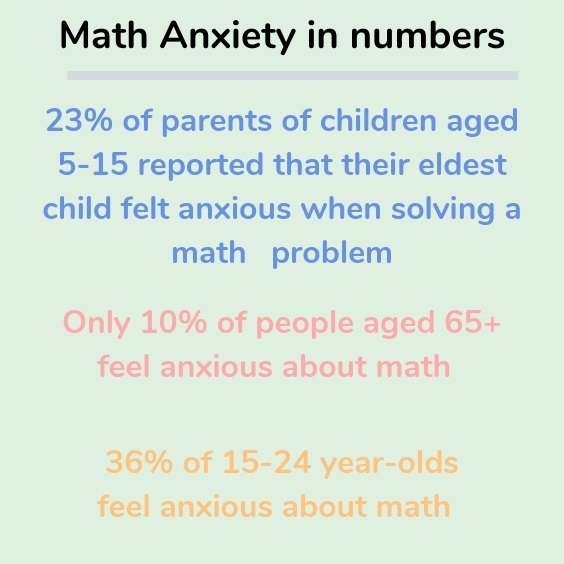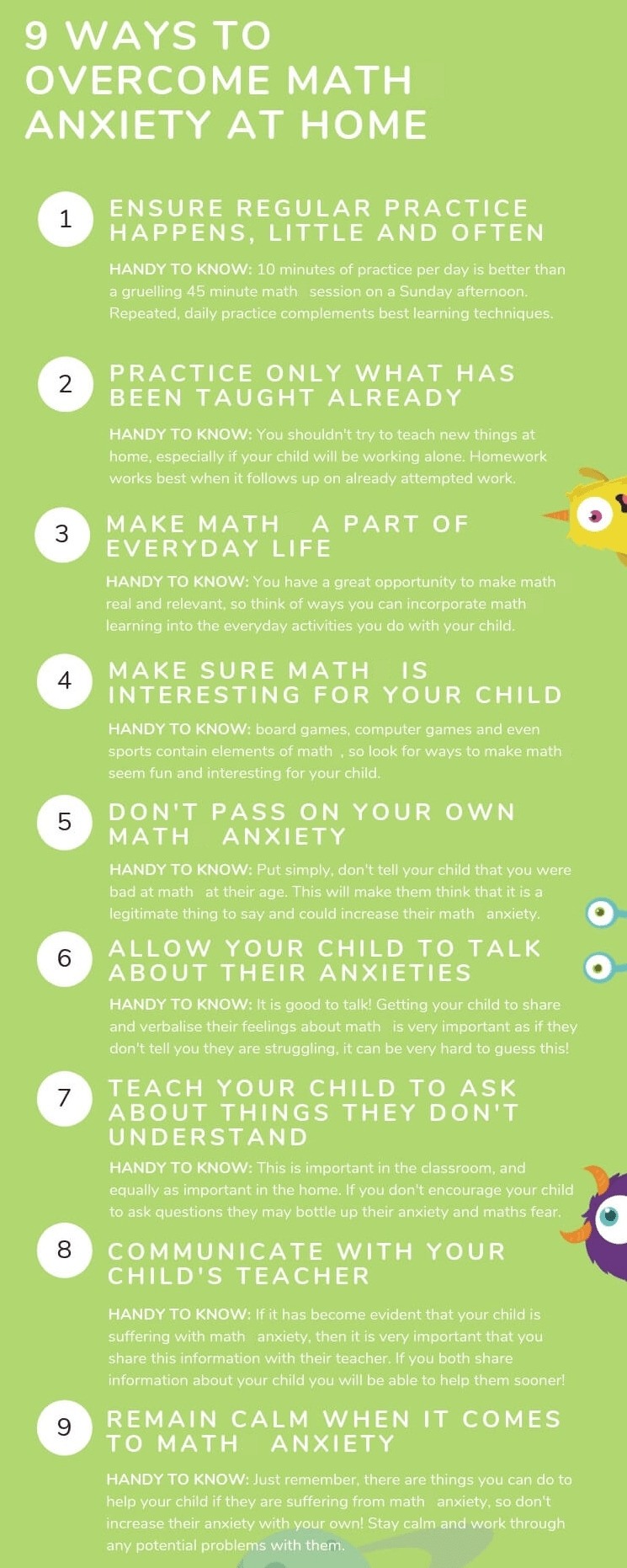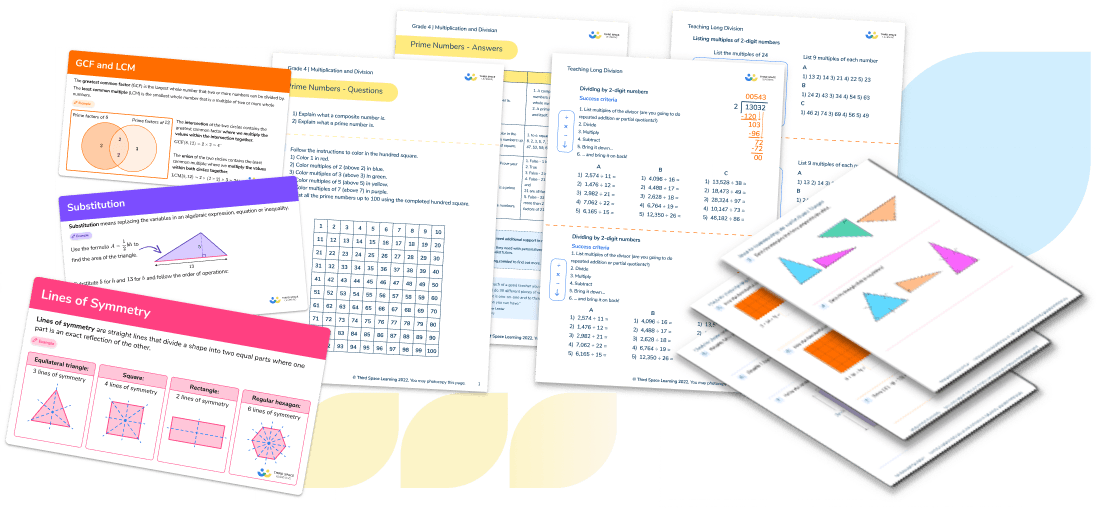Understanding Math Anxiety: How Parents And Teachers Can Support Children At School
Math anxiety is a phenomenon that has been around for more than 50 years, and it is something that affects many young mathematicians throughout elementary school and beyond. Here former mathematics leader and Deputy Head shares what he’s learned about how to overcome it.
What is math anxiety?
Math anxiety is a negative emotional reaction to mathematics, leading to varying degrees of helplessness, panic and mental disorganization, that arises among some people when faced with a mathematical problem.
“A negative emotional reaction to mathematics, leading to varying degrees of helplessness, panic and mental disorganization, that arises among some people when faced with a mathematical problem.“
Well, that is the definition of math anxiety, according to the Math Anxiety Trust, but reactions to the concept of math anxiety among adults may be divided. Some of you may not even know that it’s a real thing. Other people reading that statement are sitting there saying ‘That’s me!’?
From tortuous to teaching: how I dealt with my own math anxiety
I remember finding ways to get out of math lessons as a youngster.
My favorite trick was to offer to tidy up the teacher’s cupboard – I even clearly remember stacking the math textbooks neatly on the shelves, feeling inwardly smug that I did not have to open them and attempt the questions inside.
I recall my dad spending what seemed like hours with me trying to help me to understand negative numbers and how to calculate them – unfortunately, his pictures of eggs and eggcups didn’t help at all although I appreciated his efforts!
My relationships with my middle school math teachers were never great – firing a huge elastic band into one’s eye really didn’t help (will always regret that) and spending most of the time chatting to literally anyone I was moved to sit with wasn’t exactly productive either.
In fact, in middle school, I hated math.
It was only when I became a teacher, and had to teach math, that I began to understand math for myself.
In order to teach it to the children, I had to know what I was talking about, and by breaking things down into small steps and striving to understand the inner workings of the mathematical processes I was teaching, I became much more confident in math.
In fact, I spent three years recently leading on math throughout school and have written many articles about how to teach elementary math – that’s progress!
It’s also an encouragement: math anxiety can be overcome.
But before we look at how to overcome it, let’s look at the facts and figures surrounding math anxiety.
This is a fantastic video from the team at childline which explains what anxiety is in child friendly terms.
Does math anxiety affect mathematics performance?
A 2018 Ipsos MORI poll found that 23% of parents of children aged 5-15 report that their eldest child often feels anxious when attempting the solving of mathematical problems, and that math anxiety seems to be affecting the more recent generations.
The study found that 36% of younger (15-24 year-olds) people feel anxious about math, compared to 10% of older people (65+), and some studies suggest that math anxiety can begin very early when young children are learning basic number skills.

A fear of math isn’t restricted by age, gender, or even position in school
In addition to the age-based anxiety discussed above, it is also worth noting that recent research from Cambridge University found that girls are more likely to report math anxiety than boys.
In another recent survey at two schools (a boys’ and a girls’ school), along with 25% of children in each school identifying that they suffer from math anxiety, 20% of the staff in one of the schools said that they too experience math anxiety.
This means that not only are our students feeling panicky with math, but some of their teachers are as well.
Some research shows that when teachers experience math anxiety they can pass it on to their students, especially in the case of female teachers and female students.
This shows just how far reaching math anxiety is in the modern day, and illustrates why we need to pay it more attention than we currently do.
“Teachers, parents, brothers and sisters and classmates can all play a role in shaping a child’s maths anxiety.” – Ros McLellan, co-author on a paper on Understanding Mathematics Anxiety.
Math often causes more anxiety than other school subjects
Many point out that we don’t treat reading the same as we do math. For example we don’t say
“Oh I was never any good at reading.”
or
“Reading is too difficult for me.”
And yet, many of us say the very same things about math.
Is this as a result of math anxiety, or do these attitudes contribute to math anxiety?
What causes math anxiety?
There are three theories that link math anxiety and math performance:
- Poor performance leads to higher math anxiety (deficit theory).
- Math anxiety leads to poor performance in math (anxiety model).
- A vicious cycle: higher anxiety contributes to poor performance; poor performance contributes to higher anxiety (reciprocal theory).
At the moment there isn’t an agreement as to which of these theories, if any, is correct.
What is known is that they are linked: if a child suffers from math anxiety, they are more likely to perform poorly; if a child performs poorly, they are more likely to suffer from math anxiety.

What are the signs of math anxiety
Math anxiety is more than just a lack of confidence in tackling a new and harder problem in math.
- At a most basic physical level, children often try to do anything to avoid being anywhere near any kind of math – my hiding in a small closet was a classic version of this!
- Classic physical symptoms include shaking, sweating, nausea and any nervous reactions like nail biting or lip biting.
- A sense of helplessness is common and can lead to shutdown where a child stops listening or evening trying
- Confusion and frustration may then lead to crying and raging
- Feelings of tension and extreme stress before and during exams may be such that additional time and support may be required
Overcoming math anxiety at home and at school
So what do we do for those children who, like a younger me, look at a math problem and just see a swimming blur of numbers and symbols and feel a sickness in the pit of their stomach?
How do we help those who feel overwhelmed by a math question to the point where they just want to cry out in anguish?
Fortunately, there are a number of things teachers and parents can do.
How to help a child in your class overcome math anxiety
The best thing one can do as a teacher is just to be on the lookout for math anxiety; simply by identifying it at an early stage of a child’s numeracy development, you will be better placed to support them.
Parents can do a lot to support a child with math anxiety at home – see the tips below. In class, however, your role is to be ready to adjust your teaching approach to accommodate the potential triggering of high levels of math anxiety.
So for example be aware of the demands that learning new content can place on working memory and ensure that, wherever possible you have designed your activities with cognitive load theory in mind. If a child starts to experience cognitive overload this can trigger math anxiety symptoms.
Break new teaching moments down into their smallest components so that your learners can continue to have small wins on their way to experiencing challenge.
Build up confidence with some standard definitions and ways of explaining that children can start to internalize and know by heart. Sentence stems are fantastic for this.
Provide lots of practice opportunities, particularly through example problem pairs which enable children to feel supported as they progress.
Don’t be afraid of providing additional concrete resources even for middle and high school students when working on manipulation of numbers. By starting from the concrete you can ground young students’ understanding of a new math idea and then move gradually from this to the more conceptual.
Where resources allow, dedicated one to one math interventions, such as those provided by Third Space Learning, are the gold standard in breaking through math anxiety barriers; tutors are trained to support, coach and nurture an anxious child through their online math lesson.
How to help your child overcome math anxiety at home
Below is a list of some of the ways you can help a child to overcome their math anxiety at home.
Make sure you do regular practice, little and often
Parents can sometimes expect too much of children at home after a day at school, and while it is important that practice is done, make sure you are not pushing your child to do too much.
10 minutes a day is better than a grueling 45-minute session on a Sunday afternoon. This 10-minute math activity is a prime example of something simple you can do at home to help your child.
This repeated, daily practice complements what we know about how we learn best; if we regularly have to recall something, drawing it out of our memory we are more likely to be able to remember it for longer.
We also know that we can suffer an overload in our brains if we try to do too much – especially too many different things – so try to keep the work focused on one or two mathematical concepts at a time.
Practice only what has been taught already
Don’t try to teach new things at home, especially if you are expecting your child to do most of the work on their own.
Homework for elementary-aged children works best when it is a follow-up of work that they have already done at school and when it is done with a parent.
Younger school children do not yet have the self-regulation skills they need to sit down and complete a piece of homework themselves so it is important that if you want to help your child with their math anxiety, you accompany them.
Make math a part of everyday life
Parents have a real opportunity to make math real – arguably even more than teachers do at school.
For example, when you are out and about in ordinary life, going to the grocery store, doing DIY jobs, cooking in the kitchen, and so on, there are plenty of opportunities to have math-based discussions (you don’t always have to ask them questions).
You could help them to understand coin denominations when giving pocket money; ask them what the time is and talk about how long it will be until dinnertime; discuss when setting the table how, if each person has three pieces of cutlery, and there are five people eating, that there will be 15 pieces of cutlery on the table.
When you start to look for math opportunities in everyday life you will start to notice them everywhere!
In a rush and want to come back to these points later? Save this handy infographic:

Make sure math is interesting for your child
Not only can you look for natural opportunities, but you can also introduce chances to talk about and explore math.
Most board games, and many computer games, feature lots of math opportunities.
There is some evidence that enjoyment is a good motivator and that children learn when they are happier so it is worth making math into something that is fun. Third Space Learning has a range of math games you can play, suitable for all ages:
Don’t pass on your own anxiety
Don’t tell your children that you were bad at math.
This will only make them think that it is a legitimate thing to think and say.
You want them to feel like they can be good at math, and that there are no reasons as to why they shouldn’t be. Ensure that they know this and help them to maintain a positive attitude, even when the going gets tough!
Try developing some affirmations (or Mathirmations, if you will!):
- “I CAN learn my times tables.”
- “I WILL be able to find fractions of amounts.”
- “There is NO reason why I can’t be awesome at math!”
and get them to practice saying them aloud – positive self-talk may help here.
Allow your child to talk about their anxieties
Talking of talk, it’s always a good idea to get those thoughts and feelings out in the open – a problem shared is a problem halved (nice mathematical saying there).
It actually seems that, for children who suffer from math anxiety, it is a good idea to do this directly before they attempt any math – some research has shown that doing this helps people to go on to be more successful in the math task at hand.
Children should be allowed to verbalize their feelings – often this can make them feel less like they are the only one who struggles.
Simply trying to quash any anxieties around math is not a healthy way to deal with these feelings.
And remember, if it is indeed good to talk, it is also good to listen when children share these anxieties – ensure that they know and feel that they have been heard.
If your child mentions any math terminology you are not sure of, take a look at our math dictionary for kids to discover what it means.
Teach your child to ask questions when they don’t understand
This is crucial in the classroom and it is equally as important at home.
The struggling mathematician can often find it easy to hide their difficulties, finding ways to cope which don’t ever result in a better understanding.
In order to help children not to resort to these, foster the idea that it is OK to ask for help and that it is OK to make mistakes – reinforce the idea that we learn when we make mistakes and we learn when we ask for help.
Communicate with your child’s teacher
If you know that your child is suffering from math anxiety then let their teacher know. Discuss with them potential strategies for both home and school and work in a partnership.
You may be able to help them to understand something that you know about your child that perhaps they don’t.
The teacher may be able to show you how you can help your child with a particular bit of math that they are struggling with. By working together, you will have the best chance of helping your child deal with, and overcome, math anxiety.
Remain calm when it comes to math anxiety
The most important thing to remember is to keep your cool if your child is showing signs of math anxiety. At some point during their primary school life, most children will come up against a challenging area of mathematics and seem to struggle.
All you need to do in this scenario is remain calm, and use the tips you have learned in this blog to steer them through their troubles and help them come out the other side as confident mathematicians!
Read more:
Has Teaching Post-Covid Felt Different?
Do you have students who need extra support in math?
Give your students more opportunities to consolidate learning and practice skills through personalized math tutoring with their own dedicated online math tutor.
Each student receives differentiated instruction designed to close their individual learning gaps, and scaffolded learning ensures every student learns at the right pace. Lessons are aligned with your state’s standards and assessments, plus you’ll receive regular reports every step of the way.
Personalized one-on-one math tutoring programs are available for:
– 2nd grade tutoring
– 3rd grade tutoring
– 4th grade tutoring
– 5th grade tutoring
– 6th grade tutoring
– 7th grade tutoring
– 8th grade tutoring
Why not learn more about how it works?
The content in this article was originally written by primary lead practitioner Aidan Severs and has since been revised and adapted for US schools by elementary math teacher Christi Kulesza.




